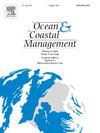Navigating the impact of multilingual packaging on the functional and emotional value of ocean and coastal tourism products
IF 5.4
2区 环境科学与生态学
Q1 OCEANOGRAPHY
引用次数: 0
Abstract
Enhancing tourists' perceptions through diverse linguistic strategies in product packaging to encourage purchase behavior and promote sustainable consumption has become a critical focus for destination management, particularly in the context of ocean and coastal tourism. Drawing on cultural identity theory, this study employs oyster sauce, a product with distinct marine associations, as the experimental stimulus to explore how different language portfolios on packaging influence tourist behavior. Three studies were conducted, each testing the effects of monolingual, bilingual, and trilingual packaging formats. A total of 445 participates were recruited, with a final valid sample is 397 respondents. The empirical analysis employed structural equation modeling (SEM) to examine the influence of different packaging language strategies on tourists' perceptions of both functional value and emotional value, and their subsequent purchase intention. In addition, comparative analyses were performed to assess the relative impact of the monolingual, bilingual, and trilingual packaging conditions. The findings reveal that monolingual and bilingual packaging significantly enhance tourists' perception of functional value, while trilingual packaging more effectively stimulates emotional value, thereby leading to stronger purchase intentions. Furthermore, the study identifies cultural identity as a key moderating variable in multilingual packaging contexts, influencing the strength and direction of tourists’ responses to linguistic cues. These results provide valuable insights into how tourists interpret and respond to multilingual packaging, offering practical guidance for the tourism sector in developing targeted promotional strategies. By aligning product communication with cultural values and tourist identity, stakeholders can not only increase purchase likelihood but also contribute to sustainable development goals in the ocean and coastal tourism sector.
导航多语言包装对海洋和沿海旅游产品的功能和情感价值的影响
通过产品包装中的多种语言策略来增强游客的感知,以鼓励购买行为和促进可持续消费,已成为目的地管理的关键焦点,特别是在海洋和沿海旅游的背景下。本研究运用文化认同理论,以具有鲜明海洋联想的产品蚝油为实验刺激,探讨不同包装语言组合对游客行为的影响。进行了三项研究,每项研究都测试了单语、双语和三语包装格式的效果。共招募了445名参与者,最终有效样本为397名受访者。实证分析采用结构方程模型(SEM)考察了不同包装语言策略对游客功能价值和情感价值感知的影响,以及游客随后的购买意愿。此外,还进行了比较分析,以评估单语、双语和三语包装条件的相对影响。研究发现,单语和双语包装显著增强了游客对功能价值的感知,而三语包装更有效地激发了情感价值,从而产生了更强的购买意愿。此外,研究还发现文化认同是多语言包装背景下的一个关键调节变量,影响游客对语言线索的反应强度和方向。这些结果为了解游客如何解释和回应多语言包装提供了有价值的见解,为旅游部门制定有针对性的促销策略提供了实用指导。通过将产品传播与文化价值观和游客身份相结合,利益相关者不仅可以增加购买可能性,还可以为海洋和沿海旅游部门的可持续发展目标做出贡献。
本文章由计算机程序翻译,如有差异,请以英文原文为准。
求助全文
约1分钟内获得全文
求助全文
来源期刊

Ocean & Coastal Management
环境科学-海洋学
CiteScore
8.50
自引率
15.20%
发文量
321
审稿时长
60 days
期刊介绍:
Ocean & Coastal Management is the leading international journal dedicated to the study of all aspects of ocean and coastal management from the global to local levels.
We publish rigorously peer-reviewed manuscripts from all disciplines, and inter-/trans-disciplinary and co-designed research, but all submissions must make clear the relevance to management and/or governance issues relevant to the sustainable development and conservation of oceans and coasts.
Comparative studies (from sub-national to trans-national cases, and other management / policy arenas) are encouraged, as are studies that critically assess current management practices and governance approaches. Submissions involving robust analysis, development of theory, and improvement of management practice are especially welcome.
 求助内容:
求助内容: 应助结果提醒方式:
应助结果提醒方式:


